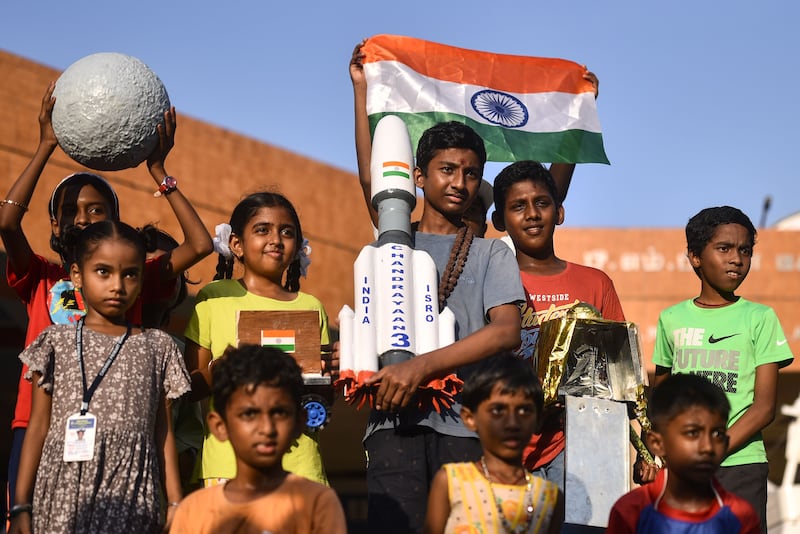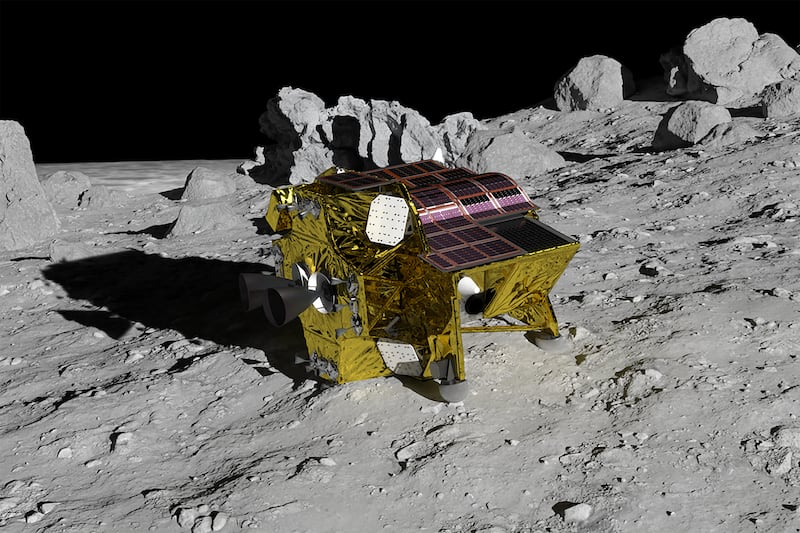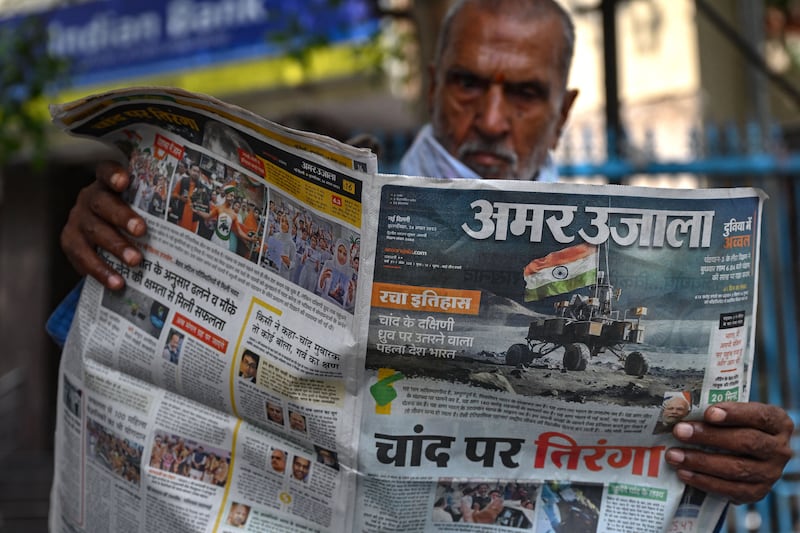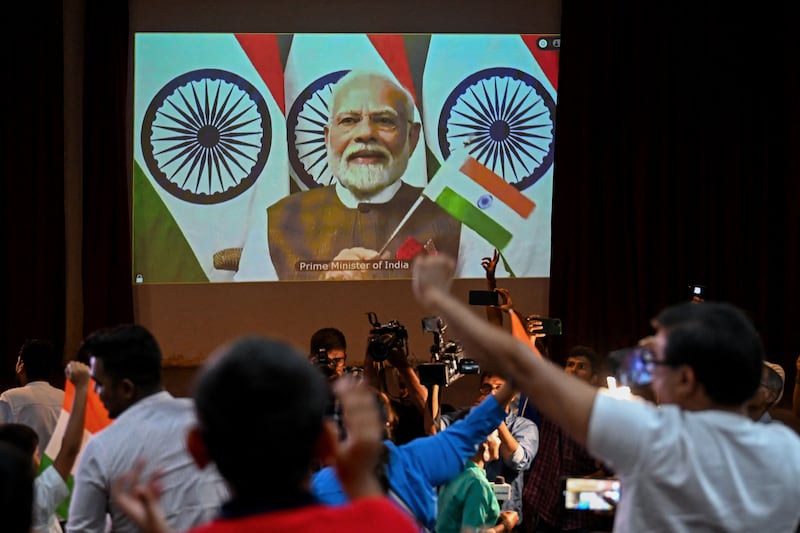A roar of triumph swept across mission control in Bengaluru as Chandrayaan-3′s lander gently touched the lunar surface last Wednesday. “India is on the moon,” said a smiling and obviously relieved S Somanath, chair of the Indian Space Research Organisation.
The sense of history was palpable – not just because India is only the fourth country to land on the moon, after the US, China and Russia – but because Chandrayaan-3′s Vikram lander is also the first to touch down near the unexplored south pole.
It will not be the last. Half a century after the end of the cold war-era space race between the Soviet Union and the US, an unprecedented number of countries are preparing their own lunar adventures.
Japan’s space agency is due to attempt its own uncrewed lunar landing shortly, while South Korea is planning the same this year. Others such as Canada, Mexico and Israel are planning to send rovers to explore the lunar surface. Six international space agencies are partnering with Nasa’s Artemis programme, which aims to return humans to the moon by 2025. Meanwhile, China is planning to send its taikonauts to the lunar surface by 2030.
READ MORE
During the 1960s, when the US and the USSR raced to be the first to set foot on the Earth’s only natural satellite, lunar exploration was mostly directed by governments and conducted by national space agencies. Although there were spin-off technological and economic benefits from space programmes, going to the moon was mostly about national pride.

More than half a century later, the actors and the motives have changed. While exploration, including lunar missions, is still dominated by big economic powers, the use of space more generally has widened to include many more countries and private companies.
“The technology for space has come down a lot in cost and it’s been commoditised in some aspects,” says Brian Weeden, director of programme planning at the Secure World Foundation, a US think tank focused on the sustainable use of space.
“That’s also why you’re seeing more countries exploring launch vehicles ... [and] getting interested in space. And when they get interested in space, the moon comes out as both a lofty but achievable goal.”
Beyond national prestige – still a significant factor in moon landings – Weeden says many of the lunar missions are aimed at determining “what is actually there that is useful”.
“Some think there is huge military, strategic and economic value in having a presence on the moon. Others think there are resources we need. To be honest, we don’t know.”
Pole positioning
India’s choice of the south pole for its landing was significant. When the last Apollo mission left the moon in 1972, scientists judged it to be dry and barren. But since then probes have indicated that large deposits of frozen water and rare earth metals could be hidden in the south pole’s cold dark craters.
Both China and the US want to use the region as a base camp to explore the farthest reaches of the moon, with the longer-term goal of learning how to live and work on another planet. Its precious water resource, if not used for drinking, could be broken down into hydrogen for fuel or oxygen to breathe. And the hope is that with a permanent presence, more valuable resources might be found on the moon to support missions exploring even farther into deep space.
“Our goal is to learn how to live and operate on the moon and do the science on the moon, so that when we can, we go on to Mars,” says Jim Free, Nasa’s associate administrator for exploration systems development.

Scenting political willingness to spend big on lunar missions – Nasa alone is spending some $93 billion on Artemis to 2025 – companies around the world are also piling in. US companies Intuitive Machines and Astrobotic are vying to operate the first commercial lunar landings this year after Japan’s ispace failed in April.
“There is a lot of momentum right now,” says Dallas Kasaboski, analyst with space consultants NSR and author of its annual Lunar Markets report. Kasaboski estimates that there are more than 400 public and private lunar missions planned between 2022 and 2032, up from a forecast of 250 missions over the same period just a year ago. While many of the current programmes – India’s included – were conceived many years ago, “the last two years has seen a much stronger development of and commitment to lunar activities”, he says.
Cheaper, but still difficult
That acceleration has been helped by the rapidly falling costs of accessing and operating in space and a growing awareness of space as a strategic domain.
The development of commercial reusable rockets such as SpaceX’s Falcon 9 is estimated by Nasa to have cut the costs – per kilogramme of payload – of launching into so-called low-Earth orbit by 95 per cent. The involvement of the private sector in development of lunar mobility and communication services promises to do the same.
Interest has also been heightened by the fact that the lunar programmes of both China and the US are finally maturing after years of delay, says Bleddyn Bowen, associate professor of international relations at the University of Leicester and author of Original Sin: Power, Technology and War in Outer Space. “They finally have the technology ready to do this.”
But while today there is roughly 100,000 times more processing power packed into an iPhone than was used by the computer that first landed man on the moon, getting to the moon is still a risky business. “Space is a place of shattered dreams and broken promises,” says Bowen. “It is still extremely difficult to get everything just right, in the moment, on the day.”

There is no satellite navigation to guide a spacecraft, no atmosphere to slow down a vehicle descending at very high speeds towards the moon’s surface. The moon is pockmarked with craters and rubble and the shadows they cast can easily be misread by sensors.
India was successful last week, but only after a previous mission in 2019 failed. Days before the Chandrayaan-3 craft touched down, Russia’s Luna-25 lander spiralled out of control and crashed.
Yuri Borisov, head of Russia’s space agency Roscosmos, blamed a 50-year hiatus in the country’s lunar programme for the failure. “The invaluable experience that our predecessors accumulated in the 1960s and 1970s was practically lost during the interruption of the programme,” he said.
But the risks of failure have not daunted China, the US or those such as India seeking the prestige that a successful lunar mission brings. Nor do they seem bothered by the uncertainty over what these costly projects will deliver. To many, the greater draw is first-mover advantage in a realm where the potential is still unknown.
“If you are a big power on the moon, then you will have a big influence in setting the details for lunar governance,” says Bowen. “The governance of the moon will be the foundation for everything else that may follow over the next 100 years and ... if the moon becomes somewhat more economically viable, then you are already on the ground floor.”
Lunar governance
It was fear of losing out to China that drove the US to refocus its space exploration efforts away from Mars and back to the moon in 2017. Within two years, China had demonstrated its lunar capability with the world’s first successful landing on the far side of the moon.
Now China and the US are targeting the south pole and even some of the same landing sites, and their plans have sparked concerns about potential conflict.
“The dominant power will be able to stymie the ambitions of others by occupying territory and attempting to police it,” writes Tim Marshall in his book on power and politics in space, The Future of Geography. “The first to establish themselves will be the first to access the potential wealth of the moon.”
Nasa chief Bill Nelson warned early this year that China could begin staking claims to territory on the moon under the guise of scientific research, an allegation dismissed by the Chinese.
But his comments have highlighted the urgent need to devise new international guidelines for exploitation of the moon, if the planned lunar missions are to succeed peacefully. The Moon Agreement of 1979 has not been ratified by Russia, China or the US, which has instead devised its own rules known as the Artemis Accords. Neither China nor Russia has signed the accords.
“It’s going to be very important that all the countries going to the moon demand a set of rules and that they are well implemented,” says David Avino, chief executive of space engineering company Argotech, which has ambitions to develop a thriving lunar business.
But the contest has already begun. And it is no longer just between the US and China. India too has ambitions to fly humans into space and its low-cost approach has so far proved highly successful. The Chandrayaan-3 mission cost a reported $73 million (about €68 million), a fraction of the cost of other landings.

India’s 54-year-old space programme was originally focused on domestic development – helping to build communications infrastructure, improve crop surveillance and warning systems for cyclones. But its priorities shifted with the rise of China.
Beijing’s first anti-satellite missile test in 2007 “resulted in a unanimous consensus that India needs to do something about protecting its own assets in space”, says Rajeswari Pillai Rajagopalan, an analyst at the Observer Research Foundation think tank in New Delhi. India finally tested its own anti-satellite missile in 2019.
India has also sought to counter China’s power by forging space exploration partnerships, including potential future missions to the moon with Japan and to Venus with France.
Along the way it has built substantial capability in space. “India is not a new space power. It launched its own satellite in its own rocket for the first time in 1980,” says Bowen.
The successful mission last week will reinforce prime minister Narendra Modi’s efforts to portray India as a top global power in economic, technological and military terms under his premiership, with the G20 leaders’ summit in New Delhi next month and national elections in 2024.

By contrast, the failure of Luna-25 has cast a shadow over Russia’s credibility as a space power. “For the last 15 years we have seen a lot of reasons to be worried about the health and vitality of Russia’s space programme,” says SWF’s Weeden. “I wouldn’t say Russia’s space programme is done, but it is on a downward trajectory while India’s is upwards.”
Bowen points out that in all the key fields needed to project power in space – infrastructure, economic services and military intelligence – India is self-sufficient.
“So if it wants to do an aggressive lunar exploration programme – yes it will take time and money – but they can do it.” – Copyright The Financial Times Limited 2023


















